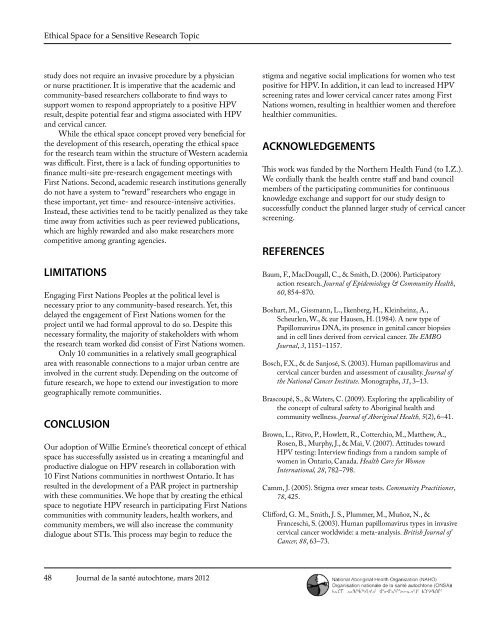Ethical Space for a Sensitive Research Topic - National Aboriginal ...
Ethical Space for a Sensitive Research Topic - National Aboriginal ...
Ethical Space for a Sensitive Research Topic - National Aboriginal ...
You also want an ePaper? Increase the reach of your titles
YUMPU automatically turns print PDFs into web optimized ePapers that Google loves.
<strong>Ethical</strong> <strong>Space</strong> <strong>for</strong> a <strong>Sensitive</strong> <strong>Research</strong> <strong>Topic</strong><br />
study does not require an invasive procedure by a physician<br />
or nurse practitioner. It is imperative that the academic and<br />
community-based researchers collaborate to find ways to<br />
support women to respond appropriately to a positive HPV<br />
result, despite potential fear and stigma associated with HPV<br />
and cervical cancer.<br />
While the ethical space concept proved very beneficial <strong>for</strong><br />
the development of this research, operating the ethical space<br />
<strong>for</strong> the research team within the structure of Western academia<br />
was difficult. First, there is a lack of funding opportunities to<br />
finance multi-site pre-research engagement meetings with<br />
First Nations. Second, academic research institutions generally<br />
do not have a system to “reward” researchers who engage in<br />
these important, yet time- and resource-intensive activities.<br />
Instead, these activities tend to be tacitly penalized as they take<br />
time away from activities such as peer reviewed publications,<br />
which are highly rewarded and also make researchers more<br />
competitive among granting agencies.<br />
LIMITATIONS<br />
Engaging First Nations Peoples at the political level is<br />
necessary prior to any community-based research. Yet, this<br />
delayed the engagement of First Nations women <strong>for</strong> the<br />
project until we had <strong>for</strong>mal approval to do so. Despite this<br />
necessary <strong>for</strong>mality, the majority of stakeholders with whom<br />
the research team worked did consist of First Nations women.<br />
Only 10 communities in a relatively small geographical<br />
area with reasonable connections to a major urban centre are<br />
involved in the current study. Depending on the outcome of<br />
future research, we hope to extend our investigation to more<br />
geographically remote communities.<br />
CONCLUSION<br />
Our adoption of Willie Ermine’s theoretical concept of ethical<br />
space has successfully assisted us in creating a meaningful and<br />
productive dialogue on HPV research in collaboration with<br />
10 First Nations communities in northwest Ontario. It has<br />
resulted in the development of a PAR project in partnership<br />
with these communities. We hope that by creating the ethical<br />
space to negotiate HPV research in participating First Nations<br />
communities with community leaders, health workers, and<br />
community members, we will also increase the community<br />
dialogue about STIs. This process may begin to reduce the<br />
48 Journal de la santé autochtone, mars 2012<br />
stigma and negative social implications <strong>for</strong> women who test<br />
positive <strong>for</strong> HPV. In addition, it can lead to increased HPV<br />
screening rates and lower cervical cancer rates among First<br />
Nations women, resulting in healthier women and there<strong>for</strong>e<br />
healthier communities.<br />
ACKNOWLEDGEMENTS<br />
This work was funded by the Northern Health Fund (to I.Z.).<br />
We cordially thank the health centre staff and band council<br />
members of the participating communities <strong>for</strong> continuous<br />
knowledge exchange and support <strong>for</strong> our study design to<br />
successfully conduct the planned larger study of cervical cancer<br />
screening.<br />
REFERENCES<br />
Baum, F., MacDougall, C., & Smith, D. (2006). Participatory<br />
action research. Journal of Epidemiology & Community Health,<br />
60, 854–870.<br />
Boshart, M., Gissmann, L., Ikenberg, H., Kleinheinz, A.,<br />
Scheurlen, W., & zur Hausen, H. (1984). A new type of<br />
Papillomavirus DNA, its presence in genital cancer biopsies<br />
and in cell lines derived from cervical cancer. The EMBO<br />
Journal, 3, 1151–1157.<br />
Bosch, F.X., & de Sanjosé, S. (2003). Human papillomavirus and<br />
cervical cancer burden and assessment of causality. Journal of<br />
the <strong>National</strong> Cancer Institute. Monographs, 31, 3–13.<br />
Brascoupé, S., & Waters, C. (2009). Exploring the applicability of<br />
the concept of cultural safety to <strong>Aboriginal</strong> health and<br />
community wellness. Journal of <strong>Aboriginal</strong> Health, 5(2), 6–41.<br />
Brown, L., Ritvo, P., Howlett, R., Cotterchio, M., Matthew, A.,<br />
Rosen, B., Murphy, J., & Mai, V. (2007). Attitudes toward<br />
HPV testing: Interview findings from a random sample of<br />
women in Ontario, Canada. Health Care <strong>for</strong> Women<br />
International, 28, 782–798.<br />
Camm, J. (2005). Stigma over smear tests. Community Practitioner,<br />
78, 425.<br />
Clif<strong>for</strong>d, G. M., Smith, J. S., Plummer, M., Muñoz, N., &<br />
Franceschi, S. (2003). Human papillomavirus types in invasive<br />
cervical cancer worldwide: a meta-analysis. British Journal of<br />
Cancer, 88, 63–73.






